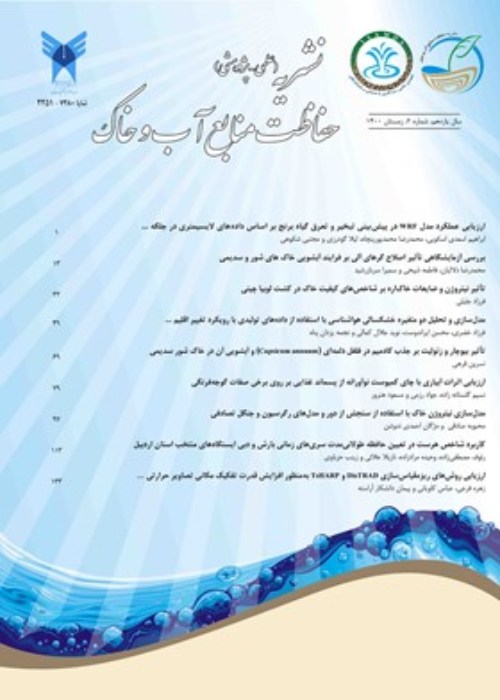Laboratory Evaluation the Organic Amender’s Effect on the Leaching Process of Saline- Sodic Soils
Soil salinity and alkalinity are one of the most important destructive soil processes, especially in arid and semi-arid regions. Sodium soils are faced with degradation of soil structure, reduction of permeability and speed of water movement in the soil, runoff increasing, decrease of land use, ventilation decreasing, and finally, decrease of crop yield. Many researches have been conducted based on physical, chemical, and biological methods to improve the saline and sodic soils, but the hybrid method is the most effective in the improvement of these soils. In this study, the effect of two organic amenders (Potassium Humate and Chicken Feather-CF) with leaching in improving some physical and chemical properties of saline and sodic soils has been investigated.
In this research, a factorial experiment in a completely randomized design with 16 treatments and 3 replications was conducted. The first factor was the type of amender (Potassium Humate and Chicken Feather), the second factor was the amount of amender (0.75 and 1.5 Weight percentage) and the third factor was leaching levels (no leaching, 45, 90, and 135 days of incubation). After sampling from depth 0 to 30 cm and measuring some physical and chemical properties of the soil samples, the amenders are mixed with the soil and the soil moisture content was delivered to the field capacity (0.7-0.8 FC). Then the soil samples were poured into the columns. Soil columns were leached at three intervals of 1.5 months with the amount of one pore volume (P.V). At each leaching stage, the properties such as soil acidity (pH), electrical conductivity (ECe) and sodium adsorption ratio (SAR) in drainage water (DW) and pH, EC, SAR, cation exchange capacity (CEC), exchangeable sodium percentage (ESP), wet aggregate stability (WAS), organic carbon (OC) and hydraulic saturation conductivity (Ks) were measured in soil columns. Statistical analyzes and the comparison of means were performed by LSD test and using SPSS17 software. The graphs were drawn with EXCEL software.
The results showed that Potassium Humate reduced the pH of the soil and increased the pH of DW. This effect was more as the amender’s weight and leaching increased. Also, Potassium Humate reduced the ECe of soil and this effect was more as the leaching increased. The findings showed that the high amount of amenders led to the high SAR in DW. As the leaching stage increased, the SAR of soil decreased in both amenders. The 1.5% of amenders amount had more effect on the reduction of SAR than the level of 0.75% in both amenders. With increasing leaching, the CEC of soil decreased. The highest CEC (31.2 cmolc.kg-1) was obtained in the CF with 1.5% of the amender’s amount. When the number of amenders increased, the CEC of soil increased. Also, when the leaching and the amount of CF increased, the ESP of soil decreased.The results showed that with increasing the leaching in Potassium Humate, the % OC of soil decreased. The WAS increased with increasing the amount of CF. The highest amount of WAS was in CF (1.5%). Potassium Humate in high amounts (1.5 %) reduced Ks. Ks decreased with increasing leaching from the second leaching stage onwards.
In general, it can be concluded that the addition of amenders increases the pH and SAR in the DW and decreases the pH (from 8.24 to 7.39), ECe (from 17.07 to 0.8 dS.m-1) and SAR (from 19.34 to 11.1 (cmolc.l-1)0.5) in the soil. Leaching increased pH and ECe in DW and decreased CEC, ESP in soil and decreased KS by increasing leaching stages after the second leaching stage. Potassium Humate reduced OC%, KS and Chicken Feather increased CEC and WAS and decreased ESP in soil. In general, Chicken Feather (with 0.75%) along with leaching is recommended to modify the saline and sodic soils.
- حق عضویت دریافتی صرف حمایت از نشریات عضو و نگهداری، تکمیل و توسعه مگیران میشود.
- پرداخت حق اشتراک و دانلود مقالات اجازه بازنشر آن در سایر رسانههای چاپی و دیجیتال را به کاربر نمیدهد.


